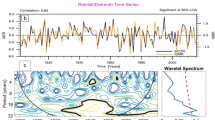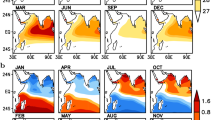Summary
A subset of world ocean monthly mean temperature climatology generated by Levitus and Boyer (1994), is utilised to describe the observed seasonal variability of the characteristics of the near-surface isothermal layer and thermocline for the entire tropical Indian Ocean (TIO). The most salient features of the observed annual cycle are described in terms of amplitude and phase of the annual and semi-annual frequencies employing Fourier analysis technique. On the annual mode, the near-surface isothermal layer depth (ILD), exhibits larger variability away from the equator with peak values in the northernmost Arabian Sea, the northernmost Bay of Bengal and the southern TIO, while on the semi-annual mode, it shows larger variability in the central Arabian Sea. The variability of the near-surface isothermal layer temperature (ILT), on the annual mode, is very weak in the warmpool region, and increases with latitude, while on the semi-annual mode, it shows larger variability in the northwestern Arabian Sea. The variability of 20°C isotherm topography (D20), on the annual mode, is weakest in the equatorial region and largest in the coastal regions of the Arabian Sea and the Bay of Bengal and in the southern T10, while on the semi-annual mode, it is prominent in the eastern and western equatorial regions. The thermocline gradient (TG) is very sharp below the warmpool region and diffuses meridionally. On the annual mode, it shows larger variability in the southern TIO, off Somalia and northernmost Arabian Sea, while on the semiannual mode, it shows larger variability in the southwestern Arabian Sea and eastern equatorial Indian Ocean. The relationship between near-surface isothermal layer and thermocline characteristics over an annual cycle are explored through correlation analysis. The correlation between ILD and ILT is strong over much of the basin with the exception of the equatorial and coastal upwelling/downwelling zones where internal ocean dynamics are important. In the southern TIO, entrainment of colder waters appears to be important in maintaining the annual cycle of ILT as strong correlation is noticed between ILT and TG. In the Indo-Pacific throughflow region and another region west of it, the annual Rossby waves appear to control D20, as correlations between D20 and other fields are strong in these regions. A similar strong correlation between D20 and ILD is also noticed in the southeastern Arabian Sea where mode-2 Rossby waves identified in numerical model solutions.
Similar content being viewed by others
References
Bauer, S., Hitchcock, G. L., Olson, D. B., 1991: Influence of monsoonally forced Ekman dynamics upon surface layer depth and plankton biomass distribution in the Arabian Sea.Deep-Sea Res.,38(5), 531–553.
Cane, M., 1980: On the dynamics of equatorial currents, with application to the Indian Ocean.Deep-Sea Res.,27A, 525–544.
Colborn, J. G., 1975:The Thermal Structure of the Indian Ocean. Honolulu: University Press of Hawaii, 173pp (IIOE Oceanogr. Monogr., 2).
Conkright, M. E., Levitus, S., Boyer, T. P., Bartolacci, D., Luther, M., 1994:Atlas of the Northern Indian Ocean. St Petersburg: Univ. of South Florida, 157pp.
Cutler, A., Swallow, J., 1984: Surface currents of the Indian Ocean (to 25° S, 100° E) (compiled from archived historic data), Rept. No. 187, 8pp and 36 charts, Meterological Office, Institute of Oceanographic Sciences, Bracknell, UK.
De, U. S., Joshi, K. S., 1995: Genesis of cyclonic disturbances over the north Indian Ocean 1891–1990. India Meteorological Department Pre-Published Scientific Report No. 1995/3, 47 pp.
Duing, J. W., Leetma, A., 1980: Arabian Sea cooling: A preliminary heat budget.J. Phys. Oceangr.,10, 307–312.
Godfrey, J. S., Alexiou, A., Ilahude, A. G., Legler, D. M., Luther, M. E., McCreary, J. P., Meyers, G. A., Mizuno, K., Rao, R. R., Shetye, S. R., Toole, J. H., Wacongne, S., 1995: The Role of the Indian Ocean in the Global Climate System: Recommendations Regarding the Global Ocean Observing System. Report of the Ocean Observing System Development Panel, Texas A and M University, College Station, TX, USA, 89pp.
Hastenrath, S., Greischar, L. L., 1989:Climatic Atlas of the Indian Ocean, Part III: Upper Ocean Structure. Madison, WI: The University fo Wisconsin Press, 26pp and 247 charts.
India Meteorological Department, 1979: Tracks of Storms and Depressions in the Bay of Bengal and Arabian Sea (1877–1970). New Delhi, India; 26 pp & 186 maps.
Jenkins, G. M., Watts, D. G., 1968:Spectral Analysis And its Applications. Holden-Day, 525pp.
Jensen, R. G., 1991: Modelling the seasonal undercurrents in the Somali current system.J. Geophys. Res.,96(C12), 22151–22167.
Ji, M., Leetma, A., Derber, J., 1995: An ocean analysis system for seasonal and interannual climate studies.Mon. Wea. Rev.,123, 460–481.
Krishnamurti, T. N., Oosterhof, D. K., Mehta, A. V., 1988: Air-sea interaction on the time scale of 30–50 days.J. Atmos. Sci.,45, 1304–1322.
Levitus, S., 1982: Climatological Atlas of the World Ocean. NOAA Prof. Paper 13, US Government Printing Office, Washington DC, 173pp.
Levitus, S., Boyer, T. P., 1994: World Ocean Atlas 1994: Volume 4: Temperature, NOAA Atlas NEDIS 4, US Dept. of Commerce, Washington DC, USA, 117pp.
McCreary, J. P., Kundu, P. J., Molinari, R. L., 1993: A numerical investigation of dynamics, thermodynamics and mixed layer processes in the Indian Ocean.Progress in Oceanography,31(3), 181–244.
McPhaden, M. J., 1982: Variability in the central equatorial Indian Ocean Part I: Ocean dynamics.J. Mar. Res.,40(1), 157–176.
Mizuno, K., Peter, B. N., Watanabe, T., 1995: Observation on subsurface temperature by voluntary ships. Japanese Experiment on Asian Monsoon (JEXAM) Annual Report April 1994-March 1995, 41–59pp.
Molinari, R. L., Festa, J. F., Swallow, J. C., 1986a: Mixed layer and thermocline depth climatologies in the western Indian Ocean. NOAA Tech. Memor. ERL AOML-64, 40pp, Atlantic Oceangr. and Meteorol. Lab., Miami, FL.
Molinari, R. L., Swallow, J. C., Festa, J. F., 1986b: Evolution of the near-surface thermal structure in the western Indian Ocean during FGGE, 1979.J. Mar. Res.,44, 739–762.
Molinari, R. L., Olson, D., Reverdin, G., 1990: Surface current distributions in the tropical Indian Ocean derived from compilations of surface buoy trajectories.J. Geophys. Res.,95, (C5), 7217–7238.
O'Brien, J. J., Hurlburt, H. E., 1974: Equatorial Jet in the Indian Ocean: Theory.Science,184, 1075–1077.
Ocean Observing System Development Panel, 1995: Scientific Design for the Common Module of the Global Ocean Observing System and the Global Climate Observing System: An Ocean Observing System for Climate, Department of Oceanography, Texas A & M University, College Station, Texas, 265pp.
Perigaud, C., Delecluse, P., 1992: Annual sea level variations in the southern tropical Indian Ocean from GEOSAT and shallow water simulations.J. Geophys. Res.,97(C12), 20, 169–20, 178.
Prasanna Kumar, S., Unnikrishnan, A. S., 1995: Seasonal cycle of temperature and associated wave phenomena in the upper layers of the Bay of Bengal.J. Geophys. Res.,100(C7), 13585–13593.
Quadfasel, D. R., 1982: Low frequency variability of the 20°C isotherm topography in the western equatorial Indian Ocean.J. Geophys. Res.,87, 1990–1996.
Rao, R. R., 1986: Cooling and deepening of the mixed layer in the central Arabian Sea during MONSOON-77: Observations and simulations.Deep-Sea Res.,33(10), 1413–1424.
Rao, R. R., 1987: Further analysis on the thermal response of the upper Bay of Bengal to the forcing of pre-monsoon cyclonic storm and summer monsoonal onset during MONEX-79.Mausam,38(2), 147–156.
Rao, R. R., Molinari, R. L., Festa, J. F., 1989: Evolution of the climatological near-surface thermal structure of the tropical Indian Ocean I. Description of mean monthly mixed layer depth, sea surface temperature, surface current, and surface meteorological fields.J. Geophys. Res.,94(C8), 10,801–10,815.
Rao, R. R., Molinari, R. L., Festa, J. F., 1991: Surface meteorological and subsurface oceanographic atlas of the tropical Indian Ocean. NOAA Tech. Memor. ERL-AOML-69, 59pp.
Rao, R. R., 1995a:Atlas of Surface Meteorology and Surface Oceanography of the Tropical Indian Ocean. Kochi: Naval Physical & Oceanographic Laboratory, 66pp.
Rao, R. R., 1995b: Atlas of near-surface thermohaline fields of the tropical Indian Ocean from Levltus climatology, Kochi: Naval Physical & Oceanographic Laboratory, 147pp.
Rao, R. R., Molinari, R. L., Festa, J. F., 1996a: Mixed layer dynamics of the tropical Indian Ocean, II Diagnostic estimates of mixed layer temperature (Manuscript under preparation).
Rao, R. R., Sivakumar, R., Ali, M. M., 1996b: A comparison of GEOSAT and modelled sea level data with heat content in the tropical Indian Ocean, (Manuscript under preparation).
Reverdin, G., 1985: Convergence in the Equatorial Surface Jets of the Indian Ocean.J. Geophys. Res.,90(C6), 11,741–11,750.
Reverdin, G., 1987: The upper equatorial Indian ocean: The climatological seasonal cycle.J. Phys. Oceanogr.,7(8), 903–927.
Robinson, M., Bauer, R., Schroeder, E., 1979: Atlas of North Atlantic-Indian Ocean Monthly Mean Temperatures and Mean Salinities of the Surface Layer, Naval Oceanographic Office, NOORP-18, NSTL Station, Bay St. Louis, Mississippi 39522, 234pp.
Shetye, S. R., 1986: A model study of the seasonal cycle of the Arabian Sea surface temperature.J. Mar. Res.,44, 521–542.
Sprintall, J., Tomczak, M., 1990: Salinity considerations in the oceanic surface mixed layer, Ocean Sciences Institute Report No. 36, The University of Sydney, 170pp.
Srinivasan, J., Gadgil, S., Webster, P. J., 1993: Meridional propagation of large scale monsoon convective zones.Meteorol. Atmos. Phys.,52, 15–35.
Stramma, L., 1992: The South Indian ocean current.J. Phys. Oceanogr.,22, 421–430.
Szabados, M., Bailey, R., Rual, P., Rebert, J. P., Ji, M., 1995: The TOGA XBT program: the use of upper ocean thermal data for analysis and prediction of climate variability. Abstracts of International Scientific Conference on Tropical Oceans Global Atmosphere. Melbourne, Australia, 116–117.
Vinayachandran, P. N., 1995: The Bay of Bengal circulation in an ocean general circulation model. Ph D Dissertation, 167pp
Woodberry, K. E., Luther, M. E., O'Brien, J. J., 1989: The wind driven seasonal circulation in the southern tropical Indian Ocean.J. Geophys. Res.,94(C12), 17,985–18,002.
WOCE, 1993: Workshop on the use of sub-surface thermal data for climate studies. Brest, ITPO Report No. 9, WOCE Report No. 110/93, 60pp.
Wyrtki, K., 1971:Oceanographic Atlas of the International Indian Ocean Expedition. Washington DC: Natl. Sci. Found., 531pp.
Wyrtki, K., 1973: An Equatorial Jet in the Indian Ocean.Science,181, 262–264.
Author information
Authors and Affiliations
Additional information
With 5 Figures
Rights and permissions
About this article
Cite this article
Rao, R.R., Sivakumar, R. Seasonal variability of near-surface isothermal layer and thermocline characteristics of the Tropical Indian Ocean. Meteorl. Atmos. Phys. 61, 201–212 (1996). https://doi.org/10.1007/BF01025705
Received:
Issue Date:
DOI: https://doi.org/10.1007/BF01025705




